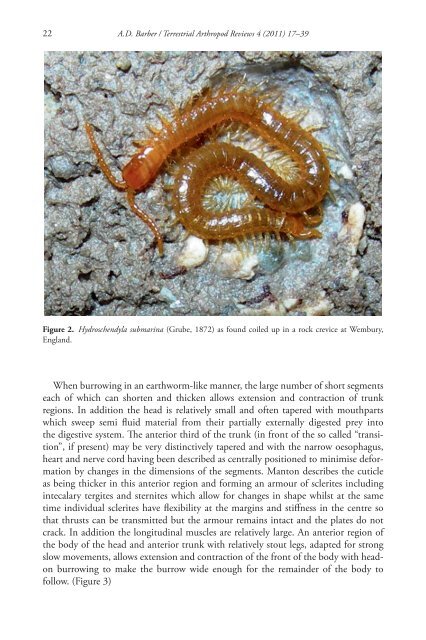Geophilomorph centipedes and the littoral habitat - Books and ...
Geophilomorph centipedes and the littoral habitat - Books and ...
Geophilomorph centipedes and the littoral habitat - Books and ...
Create successful ePaper yourself
Turn your PDF publications into a flip-book with our unique Google optimized e-Paper software.
22 A.D. Barber / Terrestrial Arthropod Reviews 4 (2011) 17–39<br />
Figure 2. Hydroschendyla submarina (Grube, 1872) as found coiled up in a rock crevice at Wembury,<br />
Engl<strong>and</strong>.<br />
When burrowing in an earthworm-like manner, <strong>the</strong> large number of short segments<br />
each of which can shorten <strong>and</strong> thicken allows extension <strong>and</strong> contraction of trunk<br />
regions. In addition <strong>the</strong> head is relatively small <strong>and</strong> often tapered with mouthparts<br />
which sweep semi fl uid material from <strong>the</strong>ir partially externally digested prey into<br />
<strong>the</strong> digestive system. Th e anterior third of <strong>the</strong> trunk (in front of <strong>the</strong> so called “transition”,<br />
if present) may be very distinctively tapered <strong>and</strong> with <strong>the</strong> narrow oesophagus,<br />
heart <strong>and</strong> nerve cord having been described as centrally positioned to minimise deformation<br />
by changes in <strong>the</strong> dimensions of <strong>the</strong> segments. Manton describes <strong>the</strong> cuticle<br />
as being thicker in this anterior region <strong>and</strong> forming an armour of sclerites including<br />
intecalary tergites <strong>and</strong> sternites which allow for changes in shape whilst at <strong>the</strong> same<br />
time individual sclerites have fl exibility at <strong>the</strong> margins <strong>and</strong> stiff ness in <strong>the</strong> centre so<br />
that thrusts can be transmitted but <strong>the</strong> armour remains intact <strong>and</strong> <strong>the</strong> plates do not<br />
crack. In addition <strong>the</strong> longitudinal muscles are relatively large. An anterior region of<br />
<strong>the</strong> body of <strong>the</strong> head <strong>and</strong> anterior trunk with relatively stout legs, adapted for strong<br />
slow movements, allows extension <strong>and</strong> contraction of <strong>the</strong> front of <strong>the</strong> body with headon<br />
burrowing to make <strong>the</strong> burrow wide enough for <strong>the</strong> remainder of <strong>the</strong> body to<br />
follow. ( Figure 3 )









![Am HaSefer [Volk des Buches] - Books and Journals](https://img.yumpu.com/20648352/1/174x260/am-hasefer-volk-des-buches-books-and-journals.jpg?quality=85)







